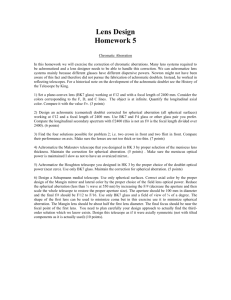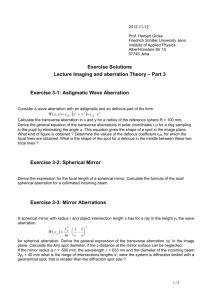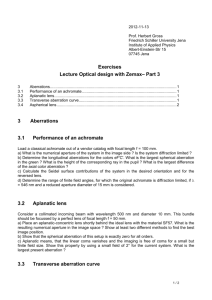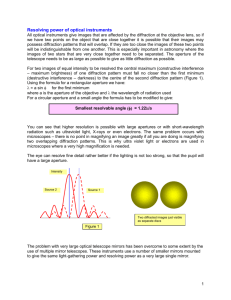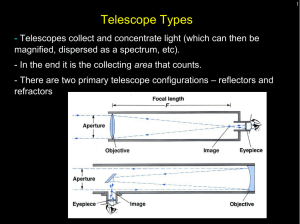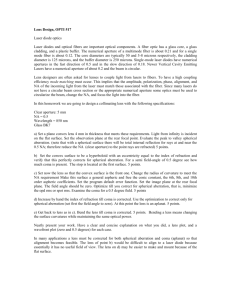Document 14223434
advertisement
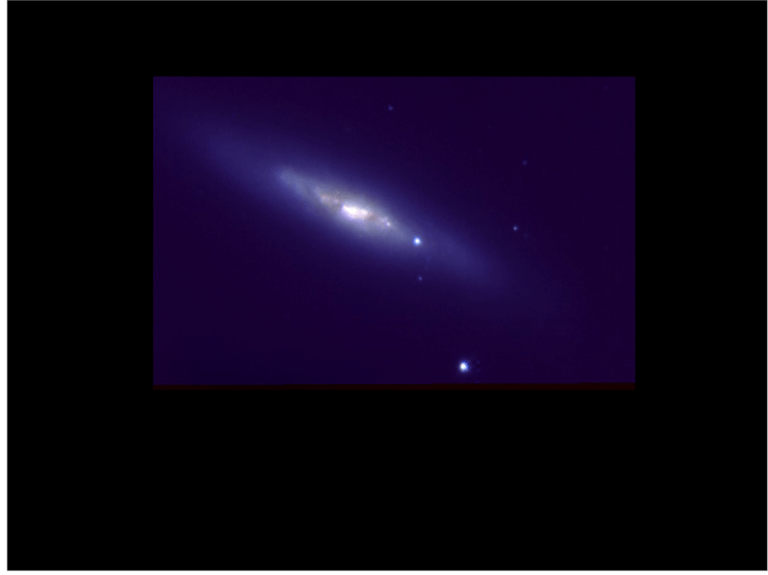
Diverging Optics and Barlow Lenses ● ● “Negative” lenses cause rays to diverge (or to converge less rapidly). Placing a negative lens in a converging beam (Barlow configuration) increases the effective focal length of the system, increasing magnification for a given eyepiece. F objective Magnification = F eyepiece Ray Tracing ● Calculating ray trajectories as they encounter reflective or refractive surfaces is straightforward. – ● angle of incidence = angle of reflection / Snell's Law In computer graphics/animation once can render realistic scenes with distributed light sources. Ray Tracing ● ● Calculating ray trajectories as they encounter reflective or refractive surfaces is straightforward. For astronomical optics one typically traces rays from a point source at infinity (parallel rays) to the focal plane. Optics, Ray Tracing, and Optical Design ● Ray traces can by physical as well as computational. Optics, Ray Tracing, and Optical Design Geometrical vs. Physical Optics A raytrace of a parabolic mirror will produce an infinitesimally small point image for an object on the axis of a parabola at infinite distance. In reality, the image size is limited by diffraction to an Airy pattern. http://library.thinkquest.org/22915/reflection.html Single Slit Diffraction ● Each point on a wavefront acts like a source (rock in a pond). – For an infinite plane wavefront the superposition of all of these sources propagates the plane wave without distortion. – The sources constituting only a segment of a plane wave will interfere constructively and destructively. – The effect is wavelength dependent. Single Slit Diffraction ● Each point on a wavefront acts like a source (rock in a pond). – For an infinite plane wavefront the superposition of all of these sources propagates the plane wave without distortion. – The sources constituting a segment of a plane wave will interfere constructively and destructively. – The magnitude of the effect is wavelength dependent. The Airy Pattern ● ● ● A circular aperture is the two dimensional analog of the single slit. Diffraction blurs light passing through a clear circular aperture. The larger the aperture the smaller the angular blur. The size of the blur is wavelength dependent. Short wavelengths produce sharper images through the same aperture. λ FWHM = 1.03∗ D λ first null = 1.22∗ D λ first ring = 1.64∗ D The Airy Pattern ● ● ● A circular aperture is the two dimensional analog of the single slit. Diffraction blurs light passing through a clear circular aperture. The larger the aperture the smaller the angular blur. The size of the blur is wavelength dependent. Short wavelengths produce sharper images through the same aperture. λ FWHM = 1.03∗ D λ first null = 1.22∗ D λ first ring = 1.64∗ D The Airy Pattern The mathematical form of the Airy Pattern is related to the Bessel function of the first kind of order one. πD 2J 1 sin θ λ I (θ) = I o πD sin θ λ ( ( J 1 ( x) I (θ) ∝ x ( ) 2 ) ) 2 The Resolution/Rayleigh Criterion ● ● Two stars are considered to be “resolved” if they are sufficiently separated to fall beyond each other's first Airy nulls. Thus, formally, the limiting resolution of a telescope is 1.22 λ/D. Diffraction Limited Resolving Power A telescope operating at radio wavelengths (21 centimeters, for example)must have a huge aperture to achieve good resolution. Hubble Space Telescope – 2.4 meters The Atacama Large Millimeter Array http://www.christophmalin.com/files/BIGchile_cm_117.jpg.jpg Real “Point Spread Functions” ● ● Telescope apertures are often clear “circles” Typically telescope apertures are not not clean unobstructed circles. The diffraction pattern is the Fourier transform of the clear aperture. Real “Point Spread Functions” Typically telescope apertures are not clean “circles” http://irsa.ipac.caltech.edu/data/SPITZER/docs/irac/iracinstrumenthandbook/images/IRAC_Instrum ent_Handbook091.png Gaming the Physics Typically telescope apertures are not clean “circles” Why Does it Matter - Poisson Statistics ● Why is a sharp high-resolution image important? – A small image minimizes the area contributing contaminating background and crams the most light into the minimum of detector pixels. ● ● Unwanted background = additional noise Detector pixels also contribute noise (readout noise). Fewer pixels per star image is better. Poisson Statistics ● The uncertainty in a measurement in a counting experiment (detecting photons in this case) is equal to the square root of the number of counts. – Quantization of light as photons makes astronomical detection a counting experiment – Even with a perfect detection system with no noise and no interfering light from background, if you detect 100 photons from a star, the measurement is uncertain by 10 photons, or 10%. uncertainty = √ counts Poisson Statistics ● The uncertainty in a measurement in a counting experiment (detecting photons in this case) is equal to the square root of the number of counts. – Quantization of light as photons makes astronomical detection a counting experiment – Even with a perfect detection system with no noise and no interfering light from background, if you detect 100 photons from a star, the measurement is uncertain by 10 photons, or 10%. – You can't measure a star to a precision of 1% until you have detected 10,000 photons from that star. – Complicating this fact is that detection systems aren't perfect and there are contaminating sources of light such as the glow of the sky (and glow of the telescope in the thermal infrared) ● and extraneous sources of noise (detector “read noise” in particular) that masquerades as additional unwanted counts Signal to Noise Ratio ● Traditionally, astronomers like to express the quality of the detection of a star or spectral line in terms of the ratio of signal to noise (signal-to-noise ratio or SNR). – In simplest terms take the number of signal counts and divide by the uncertainty. – S/N=10 is a measurement with 10% precision ● – S/N=100 is a measurement with 1% precision ● ● 100 photons gets you there if there is no source of contaminating light. 10,000 photons without contamination. In general, if the star is the only source of counts. Signal N = SNR = = Noise √N √N Accounting for Background Contamination ● ● Sources of background add to the detected photons. – These unwanted counts add additional noise. – Reducing these backgrounds improve signal-to-noise ● sharper images (landing on fewer pixels) ● selecting filter bandpasses to avoid skyglow ● cooling telescopes used in the thermal infrared If N is the number of counts from the star and B is the number of counts from the background. N SNR= √N +B ● Consider a star which covers 4 pixels, each containing contaminating background, vs. one which covers 1 pixel. – Same “N” but 4 times lower background, B, in the second case.... Sharp images are good: Seeing, Diffraction, and Resolving Power A telescope's resolving power is limited by the worst of... - atmospheric “seeing” - Image blur from atmospheric turbulence - diffraction - passing light through an aperture blurs the image. first null = 1.22∗ λ D - image quality – blurring, hopefully minimized, by the optical design Image Quality: Spherical Aberration An “on-axis” aberration that arises from different radial zones on a optic producing a focus at different distances. By its geometrical definition, a parabola is free of spherical aberration (but guilty of others). Spherical Aberration in Practice Optical Design and Spherical Aberration Mitigation ● The power of optical design is illustrated by the control of spherical aberration provided by altering lens shape (a.k.a. “bending”). ● All of the illustrated lenses have the same focal length. Coma ● Coma arises when incident rays are not parallel to the optical axis. ● ● Like spherical aberration, coma is manifested by different radial zones in the optic Each pair of symmetric points in each radial zone produces a sharp image, but since the lateral magnification is different for each pair each ring of incident rays forms an offset ring producing the classic “comma” image. Optimizing for Coma via Bending ● In a simple lens spherical aberration and coma cannot be minimized simultaneously (but close) ● The optimal shape is close to plano-convex ● but not that this is different from convex-plano ... direction matters! Astigmatism ● The optical axis and “chief ray” containing your sourcedefine a plane – the tangential plane. ● ● Ray fans in and parallel to this plane behave differently than ray fans lying in and parallel to the perpendicular “sagittal” plane In particular, the two planes focus at different distances producing sharp perpendicular “line” images at two depths with a circle of least confusion in between. http://www.microscopyu.com/tutorials/java/aberrations/astigmatism/index.html Chromatic Aberration ● ● The “lensmaker's equation” provides the focal length of a lens of a given refractive index, n. Since refractive materials have different refractive index at different wavelength, light comes to a focus in different places. 1 1 1 = (nλ −1) − F r1 r2 ( ) Chromatic Aberration ● A lens' focal length depends on the refractive index of the lens material. ● ● ● ● Refractive index (both fortunately and unfortunately) is a function of wavelength. Only one wavelength can be exactly in focus at a time. Imaging systems often function over broad bandpasses (e.g. K-band spans 2.0 – 2.4 um) Optical design mixes materials (e.g. crown and flint glass in a traditional achromat) to mitigate chromatic aberration. Controlling Chromatic Aberration ● ● Split the lens into two components (use additional surfaces to control classical aberrations). Make lenses out of materials with different dispersive properties ● The Negative lens has a higher refractive index to control spherical aberration (compensating for its weaker power). ● ● Zero spherical aberration can be achieved at only one color. The same is true of chromatic aberration. The doublet is far from perfect and some are more perfect than others. Standard doublet Abbe formula Spherical (fig 6.3) Controlling Chromatic Aberration ● The secondary spectrum in an achromatic doublet can be minimized by proper pairing of lens materials. ● Traditionally the working combination is that of crown (“soda-lime” glass - 10% potassium oxide n=1.52 ) and flint (30% lead oxide (crystal) n=1.65) for the positive and negative elements respectively. 9” Clark objective – Univ of Vermont Clark Telescopes Chromatic Aberration Correction ● A single element suffers from severe chromatic aberration. ● ● ● There are no “ideal” glasses with little or no dispersion over broad bandpasses A doublet lens can provide perfect cancellation of chromatic aberration at two wavelengths – the “achromatic doublet” ● Red the uncorrected dispersion at other wavelengths is called “secondary spectrum”. With more degrees of freedom, a triplet can substantially reduce secondary spectrum. This configuration is known as an “apochromatic triplet” Blue Controlling Chromatic Aberration Split the lens into two components (use additional surfaces to control classical aberrations). : n o i t u l o S r e l p m i S s r o r r i M e Us Make lenses out of materials with different dispersive properties The Negative lens has a higher refractive index to control spherical aberration (compensating for its weaker power). Zero spherical aberration can be achieved at only one color. The same is true of chromatic aberration. The doublet is far from perfect and some are more perfect than others. Standard doublet Abbe formula Spherical (fig 6.3) Compound Optics Virtually all optical systems contain two or more elements. Most systems can be reduced to an equivalent single thin lens. The final focus (and focal ratios) can be propagated through the system one object/image pair at a time. The Thin Lens Equation ● For a lens of a give focal length the distance at which an image is formed depends on the object's distance. – In astronomy d0 is typically infinity, so the image is one focal length away from the lens. – In compound optics each image becomes the “object” for the next element. 1 1 1 + = do di F Cassegrain Telescopes as Compound Optics A Cassegrain telescope is a two-optic system. The primary forms a real image. The secondary, which has a negative focal length, relays this real image to another real image in the focal plane behind the primary mirror. In a Cassegrain configuration the negative secondary interrupts the converging beam from the primary before the real image forms, but the image is there for calculation's sake nonetheless. Cassegrain Telescopes as Compound Optics ● A Cassegrain telescope is a two-optic system. ● ● ● The primary forms a real image. The secondary, which has a negative focal length, relays this real image to another real image in the focal plane. In a Cassegrain configuration the secondary interrupts the converging beam from the primary before the real image forms, but the image is there for calculation's sake nonetheless. Schmidt-Cassegrain Telescopes ● ● ● This configuration uses a spherical(!) primary mirror. Light enters through a refractive (but weak) “corrector plate” that compensates for the spherical aberration. No “spider” since the corrector plate supports the secondary. Gregorian Telescopes In the Gregorian configuration the concave secondary mirror lies beyond the prime focus of the primary. A real image is formed in space ahead of the secondary. Refractive Designs in the Infrared Most classical glasses become opaque at wavelengths longward of 2 micrometers. Alternative crystalline materials come to the rescue ZnS, CaF2, BaF2, ZnSe, InSb, Si, Ge, As2S3, Sapphire, Diamond... Eyepieces and Exit Pupils ● ● ● ● ● In a simple telescope the objective defines the “entrance pupil” The eyepiece produces an image of the objective – the “exit pupil” This exit pupil constrains the bundle of rays leaving the system and represents the ideal location for the eye's pupil. The exit pupil size should be smaller than the dark adapted pupil of the eye and it should be located sufficiently far from the last optic that there is some space before the eye (eye relief). Try moving your eye around at various distances behind the eyepiece and note how the field of view gets constrained. Eyepieces and Exit Pupils ● ● ● ● ● In a simple telescope the objective defines the “entrance pupil” The eyepiece produces an image of the objective – the “exit pupil” This exit pupil constrains the bundle of rays leaving the system and represents the ideal location for the eye's pupil. The exit pupil size should be smaller than the dark adapted pupil of the eye and it should be located sufficiently far from the last optic that there is some space before the eye (eye relief). Try moving your eye around at various distances behind the eyepiece and note how the field of view gets constrained. Seeing and Speckles ● The atmosphere distorts incoming plane waves. The induced tilts of the wavefronts cause different portions of the wavefront to be focused in slightly different directions causing image blur r0, the Fried Parameter ● Although atmospheric turbulence is a messy business with a spectrum of turbulent scales, identifying a single size of atmospheric turbulence cell that is characteristic of the seeing can yield simple scalings of seeing behavior. diameter = r0 Locations of Atmospheric Turbulence stratosphere tropopause 10-12 km wind flow over dome boundary layer ~ 1 km Heat sources within dome From Claire Max's Lectures on Adaptive Optics (click) Speckles, r0, and Coherence Time ● ● ● Atmospheric turbulence can be characterized by a single characteristic scale, r0, also known as the Fried parameter. – r0 varies with the seeing and wavelength. Good seeing = large r0 – In 1” seeing at 500 nm r0 is approximately 10 cm. Many characteristics then derive from r0 – The size of seeing disk is just λ / r0 (if your telescope aperture > r0) – The number of speckles is the number of r0's in the telescope aperture, (D / r0)2 – The “coherence time,” the time for the speckle pattern to change (thus the time you have to measure and correct it), is the time it takes an r0 to move its diameter at the wind speed and is typically 10's of milliseconds. In good seeing (bigger r0) you have more time. r0 depends on airmass as (airmass)-0.6 so seeing, which scales as λ/r0, degrades as (airmass)0.6 . Observe targets near to zenith if possible! Speckle simulations: 1-meter 2-meter 8-meter telecopes Speckle Interferometry ● ● Since each speckle is effectively a diffraction limited image of the target, each snapshot contains information about the target at the scale of the diffraction limit of the telescope. Extraction of this embedded, repeated small-scale pattern can be accomplished via the Fourier Transform of the image. Lucky Imaging ● Every once in a while a large atmospheric cell passes over the telescope. For an instant the telescope becomes diffraction limited. It may take thousands of short exposures to find nearly perfect images, but the results can be spectacular. 0.65” seeing Hubble Lucky (Palomar) The limitation here is exposure time since only 1 in thousand frames might be diffraction limited. Lucky Imaging ● Every once in a while a large atmospheric cell passes over the telescope. For an instant the telescope becomes diffraction limited. It may take thousands of short exposures to find nearly perfect images, but the results can be spectacular. Seeing in the Infrared ● r0 scales as λ1.2 so the scale size is larger at longer wavelengths. ● Larger scale size is beneficial ● ● ● – smaller seeing disk λ/r0 → λ-0.2 – fewer speckles (one speckle = diffraction limited) – longer coherence time (IR seeing is better than visual) Diffraction for the full aperture becomes worse going to longer wavelengths so at some point (usually around 3-5 microns for moderate aperture telescopes) telescopes no longer are affected by seeing. All of these factors favor real-time correction of the atmospheric effects at infrared wavelengths. “Adaptive optics,” using deformable mirrors to correct for atmospheric wavefront distortion, becomes practical at wavelengths longward of 1000 nm (1 micron). Intensity Adaptive Optics x ● ● Correct for atmospheric wavefront corruption in real time with a deformable mirror that “undoes” the atmosphere. Requires correction on millisecond timescales. Strehl Ratio ● Strehl is the ratio between the peak intensity of a point source (star) image and the peak that the image would have if the light were concentrated into a perfect diffraction-limited image. Wavefront Sensors and Deformable Mirrors Deformable mirror behavior Switching on adaptive optics Isoplanatic Angle ● Different lines of sight, if they are sufficiently separated in angle, will encounter different atmospheric turbulence. – r0 = 20cm at 2km altitude subtends 40 arcseconds. – Outside this isoplanatic angle star's speckle patterns, and thus deformable mirror AO correction are unrelated. Laser Guide Stars ● ● If you are observing a faint source you need to have a bright reference star within the isoplanatic angle. If no such star exists, you can make one! One strategy is to excite neutral sodium atoms in a layer about 80-100 kilometers above the ground. Laser guide star tutorial Keck laser guide star observer's page Atmospheric Transmission vs. Wavelength ● text Atmospheric Transmission vs. Wavelength ● Solution 1 – leave the atmosphere behind Spitzer Infrared Hubble – Ultraviolet, Visible, Infrared Compton Gamma-ray Observatory Atmospheric Transmission ● Molecular absorption, water in particular, contributes substantial atmospheric opacity in the infrared. Atmospheric Transmission ● Since water predominately resides in the troposphere, you just have to get into the stratosphere to see into space. Atmospheric Transmission vs. Wavelength ● Submillimeter transmission at 17000 feet Atmospheric Extinction ● Calibrating stellar photometry requires correction for loss of light passing through the atmosphere. Extinction Correction in Practice ● In each filter measure the star at a variety of airmasses (∆x below is (airmass – 1)) and determine the extinction in units of magnitudes per airmass for each observing band. ● ● ● ● ● Alternatively, have a calibrated star in your field of view (easy in the era of sky surveys. Time Variability of Extinction Systematics, I • Extinction – Rayleigh scattering (optical; proportional to static pressure and airmass) – Ozone (optical) – Water (IR) – Volcanic aerosols • Can vary by 0.1-1% • Episodic problem • IR impact uncertain SCTF 1/29/2014 Nabro eruption, 13 June 2011 (Bourassa, et al. (2012)) 68 Filter Bandpasses ● Calibrating observations precisely is dependent upon having precisely defined bandpasses. Infrared Bandpasses ● Atmospheric absorption provides natural boundaries for defining infrared filter bandpasses. Stellar Photometry with Filters ● Differences between magnitudes (which are ratios when you think about it) measured in different filters are diagnostic of temperature of blackbodies (stars). V R I Stellar Photometry with Filters ● These color differences become more diagnostic (for example of luminosity class) when you account for stellar spectral features and how they change with stellar surface gravity. The Electromagnetic Spectrum and Photons ● Wavelength alone distinguishes types of light ● At visible wavelengths – short wavelengths are blue; long are red ● Wavelength, color, and energy of a photon are all the same thing hc E=hν= λ λ∗ν=c – For reference 1um wavelength corresponds to 2x10 -19J = 1.24 eV Detectors Goal: Convert photons to an electronic signal (apologies to photography...) ● with as little accompanying noise as possible ● ideally at the quantum limit enforced by the photons. ● with as much conversion efficiency as possible ●1 photon yields 1 electron (or ideally a bunch of electrons) ● ● Primary Detection Methods ●Bulk thermal response (bolometry) ●incident radiation chages the temperature of the detector ●electrical resistance changes with temperature ●Conversion of photons to ''free'' electrons ●quantum response ●photoelectric or solid state detection ●Coherent detection ●sense wave nature (phase) of the photons ●primarily through heterodyning to lower frequencies Detectors Goal: Convert photons to an electronic signal (apologies to photography...) ● with as little accompanying noise as possible ● ideally at the quantum limit enforced by the photons. ● with as much conversion efficiency as possible ●1 photon yields 1 electron (or ideally a bunch of electrons) ● ● Primary Detection Methods ●Bulk thermal response (bolometry) ●incident radiation chages the temperature of the detector ●electrical resistance changes with temperature ●Conversion of photons to ''free'' electrons ●quantum response ●photoelectric or solid state detection ●Coherent detection ●sense wave nature (phase) of the photons ●primarily through heterodyning to lower frequencies Electron response -- free electrons / carriers A free electron is a detectable electron (via voltage or current) an electron can be free in space -- photoelectric effect or it can be ''free'' within a crystal lattice -- solid state detection The Photoelectric Effect Metals are characterized by a work function which determines the energy difference between the highest energy state for an electron within the metal and the energy of an electron in free space. A photon with energy in excess of this work function will liberate a free, detectable, electron -- the photoelectric effect Heated metals will emit free electrons -- those with thermal energy in excess of the material's work function -- thermionic emission via a Boltzmann law. The Photoelectric Effect ● ● Photomultipliers are based on the cascade amplification of individual electrons liberated by the photoelectric effect Work functions for metals are typically a few electron volts ● 1 eV = 1240 nm http://laxmi.nuc.ucla.edu:8248/M248_99/autorad/Scint/pmt.htmll The Photoelectric Effect Photomultipliers are based on the cascade amplification of individual electrons liberated by the photoelectric effect Work functions for metals are typically a few electron volts 1 eV = 1240 nm Photocathodes can be engineered to have sensitivity out to 1.5 um (obviously not using pure elemental metals...) http://hyperphysics.phy-astr.gsu.edu/hbase/tables/photoelec.html The Photoelectric Effect Shortcomings of photomultipliers poor wavelength coverage (<1.5um) poor quantum efficiency (<20% conversion of photons to electrons) thermally emitted electrons -particularly for long-wavelength devices. large single-detector area One big advantage -- photon counting Modern detection systems use semiconductor detectors which mimic the photoelectric effect in the solid state. Photons create “free” electrons within the confines of the crystal lattice. Electronic Energy Levels in Conductors An alternative approach: At large separations, electronic orbitals have “atomic” characteristics. As atomic separation decreases these degenerate states must split under the interacting potential of all of the nuclei in the crystal. The ensemble of split energy levels is a “band” which may be full, partially filled and/or overlapping with other bands Electrons which have immediately adjacent energy states can change state and thus “conduct” Electronic Energy Levels in Conductors Sodium, a metal, has a single 3s valence band electron. the 3s state is only half filled since any atom can have a second electron in th state with opposite spin. In crystalline sodium (recall any chunk of metal is an assemblage of crystalline domains) the 3s state is shared by the entire crystal. There are 2N (twice the number of atoms) 3s states in the crystal and only N electrons. Conduction is “easy” since a valence electron sees a variety of nearby open energy/momentum states. Each atom brings a fixed number of states and a fixed number of electrons. It is natural that bands sometimes end up exactly full. Electronic Energy Levels in Conductors Copper has a single 4s electron making it a natural conductor. It also has an electronic configuration where the 4s band overlaps the 3d band at the crystalline interatomic spacing. Overlap between bands also provides access to infinitesimally different energy states, permitting conduction (e.g. Magnesium – which has a filled 3s state is still an electrical conductor). Note that there are about 10²² atoms in a fist sized chunk of metal. Each atom contributes a couple of 4s energy states. The energy states span a couple of eV. The degenerate conduction band energy levels are about 10¯²² eV apart. Electronic Energy Levels in Insulators Insulators have filled energy bands which do not overlap with adjacent energy bands for the interatomic equilibrium spacing. There is no such thing as a “semiconductor”! At T=0 a material will either have overlapping energy states and is a conductor, or it will have a “bandgap” above a completely filled energy state and be an insulator. Semiconductivity (if that is a word) is a manifestation of Boltzmann factors at finite temperature – kT vs. the “bandgap”. Band Filling and Band Interactions Semiconductors Semiconductors can consist of pure elemental materials or alloys of different elements. In either case, materials with complementary filled valence shells are likely semiconductors. Carbon (diamond) is a “semiconductor” with an energy gap of 5.33 eV (0.23um)l http://pearl1.lanl.gov/periodic/default.htm Semiconductors At T=0K, the world contains only conductors and insulators. Above 0K, electrons at the top of the Fermi sea can be excited to higher energy states if the states are sufficiently ( ~kT ) close. Small bandgap materials are thus semiconductors with marginal electrical conductivity at room temperature due to thermally excited carriers. The conductivity of metals improves at low temperatures. The conductivity of semiconductors declines. Semiconductor Conductivity The population of electrons (holes) in the conduction (valence) band in an intrinsic semiconductor depends on temperature. The electrons obey Fermi-Dirac statistics, but given the large size of the bandgap vs. kT, occupancy in the conduction band follows an apparent Boltzmann law. Recall 1eV/k = 12000K E bandgap= 2∗ E−E f Semiconductor Detectors While the photoelectric effect creates free electrons semiconductors provide an analog in the solid state. Photoexcitation across the material's “insulating” bandgap produces free carries. cutoff = 1.24 m E gap eV Resulting carriers produce a change in bulk material resistance (photoconductors) Carriers can also be directly detected as an electrical current in a diode configuration (photovoltaics) Photons can also change the bulk temperature of a small piece of semiconductor changing the electrical resistance (bolometers) Silicon PbS GaAs InSb Bandgap Cutoff (um) 1.11 1.12 0.37 3.35 1.43 0.87 0.18 6.89 Note cutoff is for room temperature. Cutoffs change at cryogenic temperature due to changing lattice spacing (e.g. InSb detectors have a 5.5um cutoff at 77K). The Ideal Imaging Device The Ideal Imaging Device 17 22 14 19 16 18 21 20 17 15 12 15 23 17 15 19 22 21 14 18 19 18 27 14 13 18 16 20 12 15 22 15 15 18 25 26 15 19 21 11 20 14 21 32 102 44 25 17 14 21 15 17 11 24 54 30 21 15 14 19 24 20 13 17 15 21 15 18 21 17 19 12 18 24 15 19 14 22 22 18 17 56 11 20 15 13 18 19 21 22 20 19 18 15 22 14 15 17 20 14 Indium Bump Bonds http://gruppo3.ca.infn.it/usai/cmsimple3_0/images/PixelAssembly.png http://www.flipchips.com/tutorial10.html
